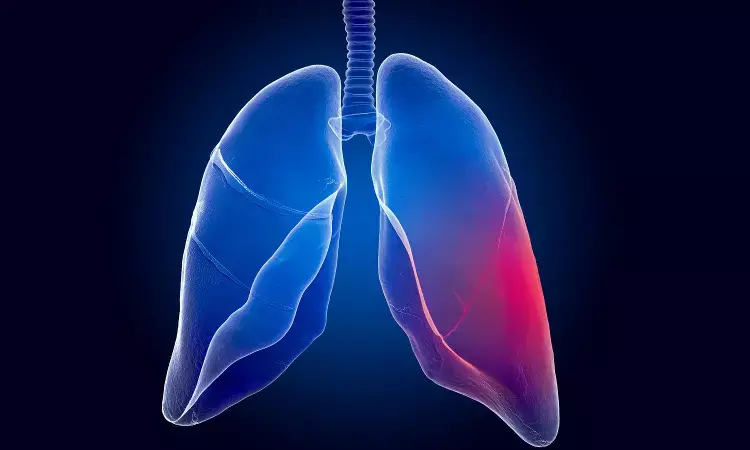- Home
- Medical news & Guidelines
- Anesthesiology
- Cardiology and CTVS
- Critical Care
- Dentistry
- Dermatology
- Diabetes and Endocrinology
- ENT
- Gastroenterology
- Medicine
- Nephrology
- Neurology
- Obstretics-Gynaecology
- Oncology
- Ophthalmology
- Orthopaedics
- Pediatrics-Neonatology
- Psychiatry
- Pulmonology
- Radiology
- Surgery
- Urology
- Laboratory Medicine
- Diet
- Nursing
- Paramedical
- Physiotherapy
- Health news
- Fact Check
- Bone Health Fact Check
- Brain Health Fact Check
- Cancer Related Fact Check
- Child Care Fact Check
- Dental and oral health fact check
- Diabetes and metabolic health fact check
- Diet and Nutrition Fact Check
- Eye and ENT Care Fact Check
- Fitness fact check
- Gut health fact check
- Heart health fact check
- Kidney health fact check
- Medical education fact check
- Men's health fact check
- Respiratory fact check
- Skin and hair care fact check
- Vaccine and Immunization fact check
- Women's health fact check
- AYUSH
- State News
- Andaman and Nicobar Islands
- Andhra Pradesh
- Arunachal Pradesh
- Assam
- Bihar
- Chandigarh
- Chattisgarh
- Dadra and Nagar Haveli
- Daman and Diu
- Delhi
- Goa
- Gujarat
- Haryana
- Himachal Pradesh
- Jammu & Kashmir
- Jharkhand
- Karnataka
- Kerala
- Ladakh
- Lakshadweep
- Madhya Pradesh
- Maharashtra
- Manipur
- Meghalaya
- Mizoram
- Nagaland
- Odisha
- Puducherry
- Punjab
- Rajasthan
- Sikkim
- Tamil Nadu
- Telangana
- Tripura
- Uttar Pradesh
- Uttrakhand
- West Bengal
- Medical Education
- Industry
Air Pollution with particulate matter about 2.5 micron increases lung damage: JAMA

A new study published in the Journal of American Medical Association shows that sulfate, ammonium, and nitrate elements of Particulate matter 2.5 (PM2.5) were linked to the most damage and were associated with baseline severity, illness progression, and death among patients with fibrotic interstitial lung diseases (fILDs), underscoring the need for reductions in pollution from human sources.
Particulate matter with a diameter of 2.5 m or less is linked to poor outcomes for people with idiopathic pulmonary fibrosis, but its links to other fibrotic interstitial lung conditions and the composition of PM2.5 are yet unknown. As a result, Gillian Goobie and colleagues carried out this study to look at the relationship between fILD patients' exposure to PM2.5 and their mortality and lung function.
Patients in this worldwide multicenter, prospective cohort research were enrolled in the Simmons Center for Interstitial Lung Disease Registry at the University of Pittsburgh in Pittsburgh; 42 sites of the Pulmonary Fibrosis Foundation Registry; and 8 sites of the Canadian Registry for Pulmonary Fibrosis. A total of 6683 individuals with fILD were enrolled in the study. The data was examined from June 1, 2021 to August 2, 2022. PM2.5 and constituent exposure was calculated using hybrid models that used satellite-derived aerosol optical depth, chemical transport models, and ground-based PM2.5 observations.
The key findings of this study were:
1. The median follow-up across the three groups was 2.9 years, with 28% of patients dying and 10% undergoing lung transplantation.
2. The cohort included 3653 men, 205 Black people, and 5609 White people.
3. The median age at enrolment was 66 years across all cohorts.
4. A hazard ratio for death of 4.40 was found in the Simmons cohort, 1.71 in the Pulmonary Fibrosis Foundation cohort, and 1.45 in the Canadian Registry for Pulmonary Fibrosis cohort.
5. Higher exposure to sulfate, nitrate, and ammonium PM2.5 components was related with higher mortality across all cohorts, and multi-constituent models revealed that these constituents were associated with the most unfavorable mortality outcomes.
6. Meta-analyses indicated consistent relationships between sulfate and ammonium exposure and mortality, as well as the rate of decline in forced vital capacity and carbon monoxide diffusion capacity, and a link between rising levels of PM2.5 multi-constituent mixture and all outcomes.
Reference:
Goobie, G. C., Carlsten, C., Johannson, K. A., Khalil, N., Marcoux, V., Assayag, D., Manganas, H., Fisher, J. H., Kolb, M. R. J., Lindell, K. O., Ryerson, C. J., & Nouraie, S. M. (2022). Association of Particulate Matter Exposure With Lung Function and Mortality Among Patients With Fibrotic Interstitial Lung Disease. In JAMA Internal Medicine. American Medical Association (AMA).https://doi.org/10.1001/jamainternmed.2022.4696
Neuroscience Masters graduate
Jacinthlyn Sylvia, a Neuroscience Master's graduate from Chennai has worked extensively in deciphering the neurobiology of cognition and motor control in aging. She also has spread-out exposure to Neurosurgery from her Bachelor’s. She is currently involved in active Neuro-Oncology research. She is an upcoming neuroscientist with a fiery passion for writing. Her news cover at Medical Dialogues feature recent discoveries and updates from the healthcare and biomedical research fields. She can be reached at editorial@medicaldialogues.in
Dr Kamal Kant Kohli-MBBS, DTCD- a chest specialist with more than 30 years of practice and a flair for writing clinical articles, Dr Kamal Kant Kohli joined Medical Dialogues as a Chief Editor of Medical News. Besides writing articles, as an editor, he proofreads and verifies all the medical content published on Medical Dialogues including those coming from journals, studies,medical conferences,guidelines etc. Email: drkohli@medicaldialogues.in. Contact no. 011-43720751


